Private Lives: Home and Family in the Art of the Nabis, Paris, 1889–1900
Reviewed by Ellen W. LeeEllen W. Lee
Senior Curator Emerita, Indianapolis Museum of Art
Email the author: Elee[at]indy.rr.com
Citation: Ellen W. Lee, exhibition review of Private Lives: Home and Family in the Art of the Nabis, Paris, 1889–1900, Nineteenth-Century Art Worldwide 21, no. 3 (Autumn 2022), https://doi.org/10.29411/ncaw.2022.21.3.27.
This work is licensed under a Creative Commons Attribution-NonCommercial 4.0 International License  unless otherwise noted.
unless otherwise noted.
Your browser will either open the file, download it to a folder, or display a dialog with options.
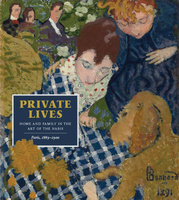
Private Lives: Home and Family in the Art of the Nabis, Paris, 1889–1900
The Cleveland Museum of Art, Cleveland
July 1–September 19, 2021
Portland Art Museum
October 23, 2021–January 23, 2022
Catalogue:
Mary Weaver Chapin and Heather Lemonedes Brown, eds.
Private Lives: Home and Family in the Art of the Nabis, Paris, 1900.
Cleveland: The Cleveland Museum of Art, 2021.
Distributed by Yale University Press, New Haven and London.
278 pp.; 308 color illus.; chronology; map of Paris; notes; checklist; bibliography; index.
$65.00 (hardcover)
ISBN-978–0–300–25759–5
While the exhibitions and literature of recent decades have thoroughly explored many facets of the Nabi art of late nineteenth-century France, Private Lives: Home and Family in the Art of the Nabis, Paris 1889–1900 sets a special focus on the very essence of the Nabi spirit—the intimacy of domestic life. Mary Weaver Chapin, Curator of Prints and Drawings at the Portland Art Museum, and Heather Lemonedes Brown, Deputy Director and Chief Curator of the Cleveland Museum of Art, explore their theme with ingenuity, taking it in intriguing new directions. They chose the work of just four members of the Nabi group—Pierre Bonnard (1867–1947), Maurice Denis (1870–1943), Félix Vallotton (1865–1925), and Edouard Vuillard (1868–1940)—to explore the domestic subjects and aesthetic approaches that characterize much of the Nabi group’s most emblematic work.[1]
The saga of the Nabi brotherhood is well known—that of a group of young, progressive artists inspired by Paul Gauguin’s (1848–1903) embrace of symbolism and the powerful realization that works of art need not recreate the visual world. They chose the name “Nabi” (Nebiim), from the Hebrew word for prophet, to signal their pursuit of a subjective approach to their art. How heady to decide that artistic expression can depend on mood or sensation rather than realism or its fleeting impression! Directly inspired by the small painting, dubbed The Talisman, that Paul Sérusier created under Gauguin’s tutelage in Pont-Aven in 1888, his confrères created their own association, with nicknames, meetings, and—most significantly—a new devotion to creating works of art endowed with nuance, mood, and a freer approach to surface pattern.
While the Nabi coterie included numerous other members with an intriguing mix of backgrounds and aesthetics, the curators limited themselves to the four artists who most thoroughly focused upon the sentiments and settings of everyday life.[2] They also offer emotional breadth to the interpretation of the exhibition topic. During their early years, the Frenchmen Bonnard, Vuillard, and Denis, and Vallotton, a Swiss native, were nurtured in the more liberal atmosphere of the Académie Julian in Paris, but even that training was too academic for their artistic aspirations. Open to the growing symbolist movement in theater and literature, as well as Gauguin’s leadership, they created art based on suggestion and emotion. Their lives, with interwoven friendships and varied personalities, led to the rich imagery unveiled by Private Lives.
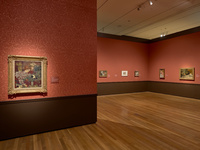
For those readers of sufficient age or interest to remember Private Lives, the 1930 Noel Coward comedy of married (and unmarried) life, this exhibition of the same name, centered upon family and home, will come as a down-to-earth variation on the theme.[3] Comprised of works from many US and European lenders, the show benefits from the rich core of promised gifts and permanent collections of the Portland and Cleveland museums. It is the first major international loan exhibition mounted by the Cleveland Museum of Art since the onset of the pandemic. That alone, however, cannot explain this visitor’s satisfaction, seeing such engaging works, many familiar and some refreshing surprises, placed in exquisitely planned settings. The entry rooms offer period-appropriate wall colors and patterned wallpapers, and the designers reduced the large scale of the galleries to the intimate size of the works with chair rails and dark upper stories that fade away to the ceilings (fig. 1).
The exhibition curators have taken this most basic of Nabi subjects and cleverly broken it down to five chapters: intimate interiors (tranquil and troubled), family life, music, gardens, and city scenes, interspersing the four artists as the themes warrant. Anyone who has ever organized a large, tightly knit exhibition (this one contains 161 objects) understands how difficult it is to sort out works that legitimately could belong to multiple categories. The flow of the exhibition has a graceful pacing, logical but not predictable, that suits the intimate nature of the subject.
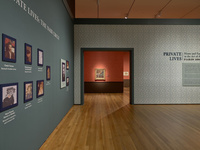
The introductory gallery sets the stage with a floral wallpaper and one refreshingly straightforward wall text citing the cast of characters: the artists, their families, friends, and associates, and certainly the best dog in all of nineteenth-century art—Bonnard’s sister’s poodle (fig. 2). They are presented via photographs or details cropped from works in the exhibition.
The simplicity of the introduction reflects the exhibition’s didactic agenda as a whole. This reviewer extends thanks for the absence of lengthy timelines and dueling chronologies. The economy of means extends to the labels, where brief, elegantly written wall texts (far more difficult to write than lengthy ones) offer insights and decipher the layered complexity of Nabi motifs. Even the wallpaper sources are revealed! The museum offered numerous free gallery chats, and sensitive to the challenges posed by the pandemic, the organizers developed virtual programs to enrich the exhibition experience.
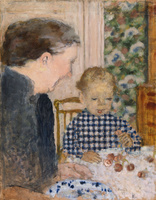
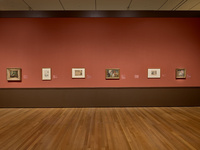
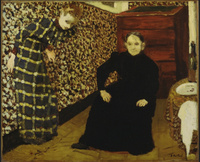
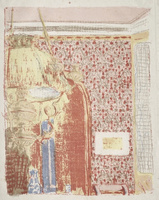
On the deep red painted and papered walls of the first galleries of “The Intimate Interior” are the works most closely associated with the Nabis—the intimate domestic interior. There the family tableaux of mealtimes and pastimes, household chores and quiet reverie, evoke the poetry of everyday life. Scenes of the joy of familial relationships and tender friendships, infused with expressive nuance and compositional complexity, are the special province of Vuillard and Bonnard. Often each artist elected an uncannily effective, novel viewpoint, and then wrapped its message and setting with competing mixes of fabric, wallpaper, and household clutter. Boy Eating Cherries (1895) shows their unrepressed use of pattern as well as Bonnard’s special prowess in rendering woven plaids (fig. 3).
Credit the expertise of the exhibition curators and the late nineteenth-century renaissance of the print movement for the suitably heavy representation of works on paper that begins with this first chapter and informs the entire show. Both Bonnard and Vuillard utilized the properties of printmaking to transfer their affinity for intimate, everyday scenes to evocative black-and-white or color lithographs. And credit the exhibition designers and recent progress in gallery lighting for avoiding the variation in light levels that used to be the nemesis of juxtaposing paintings and works on paper (fig. 4).
In the next section, “Troubled Interiors,” subtle undercurrents of tension suggested in the prior gallery bubble more forcefully to the surface. A single wall is devoted to the painting that arguably is the most psychologically potent of the genre (fig. 5), Vuillard’s Interior, Mother and Sister of the Artist (1893). In a claustrophobic room with a precipitously raking floor, Vuillard’s sister Marie seems to cling to the patterned wall, her eerily lighted face almost truncated by the low perspective. Absorbing the larger proportion of the canvas is her mother, sturdily seated with both hands fixed upon her flat black gown. Fundamental issues of mother/daughter relationships, coupled with the fact that Marie also assisted in her mother’s home workshop, easily summon a sense of inescapable anxiety.
Other powerful examples of the troubled vignette appear in lithographs from Vuillard’s ambitious print series, Landscapes and Interiors (1899), published by Parisian dealer Ambroise Vollard (1866–1939), a prime supporter of the Nabis. Bringing dazzling color and complex patterns to the gallery wall is the tour de force trio of prints, Interiors with Pink Wallpaper, I, II, and III (fig. 6). The gallery label aptly describes each sheet as an “airless enclosure,” with the wallpaper “metastasizing” across the images, obscuring figures and upending spatial relationships. The lithographs also illustrate the Nabi willingness to abandon traditional perspective in favor of overlapping patterns that emphasize the flatness of the picture plane.
No exhibition devoted to the complicated relationships captured by the Nabis would be complete without the hard edges and harsh scenarios of the Intimacies (1897–98) by Félix Vallotton. In his ten-piece series, Vallotton jettisons the subtlety of his colleagues in favor of ten inky black-and-white woodcuts that exude the artist’s cynicism about human relations. Each print presents an encounter between a man and a woman, where betrayal, dishonesty, greed, and manipulation cohabitate in well-appointed interiors. Matching Vallotton’s technical mastery is his clever scene-setting that makes it unclear who might be the guilty party, creating the suspense that compels viewers to return repeatedly to interpret this unsettling suite.
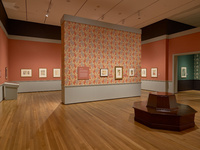
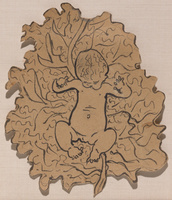
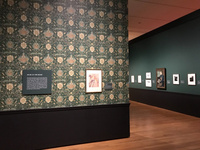
In the “Family Life” gallery that follows, the mood and the palette lighten (fig. 7). Wall colors of coral and gray coordinate with the climbing floral wallpaper. In this section, Maurice Denis (1870–1943), the ultimate family man of the Nabi group, rightfully dominates. His oeuvre is populated with tender scenes of romantic, maternal, familial, and spiritual love. Again, works on paper receive their due. The show presented a rare opportunity to see all the lithographs in the portfolio entitled Love (twelve images and a cover), published in 1899. There could not be a stronger foil to Vallotton’s Intimacies, as Denis’s delicate shades and genuine emotions are a world away from the deep contrasts and sharp pessimism of Vallotton’s suite. Inspired by his love of his wife Marthe, the images are also endowed with religious devotion and symbolist spirit.
Reflecting the curators’ deep dive into family life, they featured a genre that could not be more appropriate: the birth announcement! Tender pieces by Denis and Bonnard celebrate the arrival of new additions to their family and circle of friends, such as Bonnard’s witty image of an infant squirming on the curly forms of a cabbage leaf (fig. 8). The gallery also provides a joyous introduction to Bonnard’s rapport with his nieces and nephews.
Soothing, deep green walls and coordinating wallpaper with the intertwining vegetal forms of British designer William Morris lure the visitor into the gallery titled “Music in the Home” (fig. 9). Music was an integral part of the Nabi pursuit of mood and expression, a catalyst to inner thought and emotion. Fittingly, in Private Lives the subject is not grand and orchestral, but music studied, performed, and savored in the home. Within this gallery also lies the explanation for the poignant piano music that wafts through the exhibition, an interpretive means that certainly enhanced this visitor’s connection with the visuals. The melodies, composed by Bonnard’s brother-in-law Claude Terrasse (1867–1923), are illustrated by a suite of lithographs by Bonnard entitled Familiar Little Scenes.[4] It would be difficult to think of a body of work more intimately linked to the soul of Private Lives. Terrasse’s nineteen melodies, each dedicated to a friend or relative, evoke the simple charms of everyday life and family ties. Bonnard used energetic strokes to create their lithographic illustrations, interpreting the music with tenderness, humor, and charm.
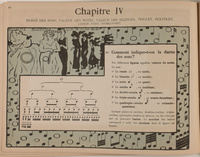
Another, slightly earlier, Terrasse/Bonnard partnership that takes center stage in this gallery is Le Petit solvège illustré (1893), a music primer for children. The extensive presentation of this project is a hallmark of the exhibition, a rare opportunity to examine the many works on paper that contribute to this remarkable undertaking. The curators have assembled a wonderful reunion of preparatory works with the finished pages, complementing the Portland Art Museum’s strength in this arena. Lucky the enfants français who could begin their music education with Terrasse’s straightforward lessons and the whimsical sketches of Bonnard. To explain the length of a note, for example, the artist used different sized women, drawing a large matron as the whole note and increasingly slender mademoiselles representing the shorter ones (fig. 10). Terrasse, clearly a kindred soul, even allowed Bonnard’s playful images to overlap and invade his sheet music.
Lest spirits become too lighthearted, another powerful suite of woodcuts by Vallotton appears in this gallery. Musical Instruments of 1896 is a series of six prints, each featuring a lone musician in a somber interior, playing an instrument for an audience of one. The artist’s clever use of black swallows up space and definition, leaving the white of the paper to define the image. Here music is a solitary rather than a social experience.
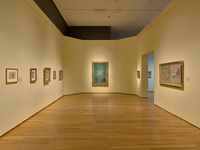
As the exhibition moves to Nabi life in outdoor settings, the intimate nature of the galleries necessarily shifts. It is more difficult to sustain the strong sense of atmosphere when the deeper hues summoning snug Parisian interiors are supplanted and the decorative wallpaper and chair rails no longer have their place. Entering the gallery titled “In the Garden” (fig. 11), the visitor breathes a new sense of air and space, with light yellow walls offering a clear vista to the large Bonnard landscape, Apple Gathering (ca. 1895–96).
While this Nabi quartet led rather urban existences, with three Parisians and Denis living in the suburb of St.-Germain-en-Laye, the artists still had access to nature via the parks and gardens that had become such an essential part of French life, as well as visits to the country homes of family and friends. With twelve works, this section is the show’s smallest. Their work from the 1890s (with the possible exception of Bonnard’s other paintings of the family orchard and his four seasons decorative panels) offered the organizers fewer works of art to choose from.[5] Many of his decorative ensembles set in the garden are fragile tempera pieces, and conservation issues may have played a role in their availability. The curators utilized scenes such as family pets at play that take place outdoors to reinforce the artists’ connection with nature.
This gallery brings the exhibition to a close on a very strong note with “The Nabi City.” An engaging mix of subjects takes Private Lives in clever directions, as the curators agilely guide the theme of intimacy into the urban arena out of doors. In a large, sky-blue gallery (though the gray blue that so often tints Parisian skies might have been a tempting alternative), Bonnard and Vuillard again hold court, glimpsing city life through print portfolios, posters, easel paintings, and interior decorations.
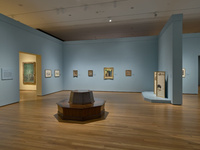
Bonnard’s powerful foray into domestic decoration, the beguiling Nursemaids’ Promenade, Frieze of Carriages (1895), has pride of place at the gallery entrance. A paradigm of wit and design, the four-panel folding screen captures the energy of children and animals at play, juxtaposing it with a stolid phalanx of nannies, their identifying ribbons flowing down their backs. In the distance is the ornamental row of cabs that halts the flattened space of these large, subtly-toned lithographs. The placement of this remarkable work is the only occasion when this reviewer mused about an alternative gallery layout. Nursemaids’ Promenade is placed several feet into the gallery, off-center to the viewer’s left (though the perspective in this gallery photograph places it on the right), sacrificing some of the work’s impact (fig. 12). It could have been riveting to have a close, direct view of the panels or, alternatively, to make a focal point of Vuillard’s tall, commanding Under the Trees (1894). However, each time other gallery arrangements spring to mind, this curator acknowledges that often there are restricting circumstances, such as security sight lines or HVAC factors, unknown to the visiting colleague, that preclude more ideal installations. In any case, Vuillard’s Under the Trees is another prime example of Nabi domestic decoration and an important addition to the gallery, no matter where it is placed. It is one of nine panels from the ambitious series entitled The Public Gardens (1894), commissioned for the home of his friend Alexandre Natanson, which depicts families and children in the Tuileries Gardens and the Bois de Boulogne.[6] This image, as well as easel paintings such as Child Wearing a Red Scarf (ca. 1891) and Little Girl at the Window (ca. 1901), show Vuillard’s special affinity for a child’s view of the world.
The final gallery sustains the curators’ emphasis on prints, putting Vuillard’s and Bonnard’s prowess on full display. Nearly the entire suite of Bonnard’s Some Scenes of Parisian Life (1899) appears, featuring his clear delight with the lithographic crayon and many of the typical sights so dear to all lovers of the City of Light. Absent from this section of the exhibition is the work of Vallotton. During the mid-1890s he produced many street scenes, and woodcuts such as The Shower (1894) or The Gust of Wind (1894) might have added a valid note on the climatic challenges of city life and given Vallotton a final moment of graphic glory in the exhibition.
The Nabi city also features Paris by night, as Bonnard and Vuillard used paintings and lithographs to evoke their city after dark. Be it a sidewalk café or a rain-soaked street, they “humanized” Paris, as the wall texts described it, summoning the same intimate spirit and layered patterns that infuse their views of the home. Some of Bonnard’s prints and a rarely seen canvas, Paris Boulevard at Night (1900), present another intriguing facet of his urban views—aspects of the city observed from the shelter of the artist’s studio or apartment. Melding the private and the public, the perspectives of nearby facades or distant streets subtly remind us of the artist maintaining that private space at the heart of this exhibition. Created at the end of the 1890s, they mark the closing years of the remarkable decade that brought us Private Lives.
The consolation for the ephemeral nature of special exhibitions is, of course, the catalogue, and the Private Lives publication is destined for long-term satisfaction and scholarly value.[7] Pleasure comes with the first glance at the dust jacket, with the Bonnard cover illustration that so aptly presents the Nabi aesthetic, to the back cover that allows Vuillard the last image, appropriately showing the backs of two endearing subjects on a Paris street. Opening the catalogue, the reader will discover colorful end papers from an 1893 map of Paris and a volume whose design is elegant and balanced.
Front matter includes a convenient chronology tailored to the book’s focus and a map that locates the artists’ favorite haunts.[8] Next are two introductory essays, followed by chapters that correspond to the exhibition’s sections, each written by one of the two co-curators. Valuable additions to the catalogue are four short essays by specialists that bring new information and perspectives to the attention of Nabi audiences.
A word about the catalogue’s placement of reproductions is in order. Each essay is plentifully illustrated by images that amplify the author’s text or stand in for works that were perhaps unavailable for loan. The works in the exhibition, however, are grouped at the end of the pertinent chapters. Their captions are not limited to the basic data on each piece but offer a brief paragraph describing the salient aspects of the work. These texts often do service as gallery labels.
To Heather Lemonedes Brown fell the assignment of introducing a subject as well-known as the Nabis. Sometimes it is easier to write completely new material than to renew a familiar subject, but the author succeeds in providing a fresh, engaging, and well-documented narrative of the Nabis, clearly explaining their formation and providing a biography of each of the four artists. The essay also allows space for topics such as the Natanson family and Denis’s role as theoretician, subjects that were harder to address in the exhibition itself.
The second essay, by Mary Weaver Chapin, elegantly prepares the reader for the intimism and mystique of everyday life at the exhibition’s core. In a sense, her task is to put into words what is often indescribable—the elusive expression of these suggestive images. The author sets the stage with a superb description of the contradictions and inherent paradox of this Nabi genre. The essay creates a context for Nabi intimism, tracing its association with symbolism, the printmaking revival, portraiture, and the decorative arts,[9] as well as insights into each artist’s approach.
Next, “Interior Dramas” moves more deeply into the range of emotions latent in the domestic scenes. There is some repetition of the previous essay here, understandable given how closely related the two essays are. (This reader found it a little confusing to avoid aligning this essay, which addressed the full spectrum of interior emotions, with the segment of the gallery entitled “Troubled Interiors,” which dealt just with the darker range of emotions.) Especially informative is the segment surveying the different scenarios that unfold around the family dining table. Paintings and prints depicting labor in the home or leisure activities can be lighthearted or mined for their dramatic quotients. Also addressed are works by Vuillard where tensions simmer and subtle drama permeates airless rooms. Closing the essay is an analysis of the unforgettable cynicism and graphic power of Vallotton’s Intimacies. “The Gender Politics of the Nabis,” a brief essay by Francesca Berry that concludes this section, analyzes the place of women’s roles and male attitudes in the artists’ lives and art.
As in the exhibition, the chapter entitled “Family Life” brings Maurice Denis and his works to the fore. The sole father among the four featured artists, Denis devoted a large portion of his oeuvre to his love for his wife Marthe and their children. He interpreted love in its many forms: sacred, romantic, familial. His Love (1899) portfolio uses tones so nuanced that the author compares them to a “visual whisper.” While Vallotton’s well-documented disdain for children naturally leaves him scant attention in this chapter, Bonnard’s and Vuillard’s attachment to their nieces and nephews provides some of this section’s most tender images. Complementing this study of family ties is Saskia Ooms’s article, “Home and Family through the Camera,” which describes the artists’ embrace of the newly invented handheld camera. Their use of the handy Kodak was naturally directed to snapshots of the domestic subjects they already favored. Though the exhibition does not include photographs, this article, as well as several catalogue illustrations, demonstrates the camera’s appeal during the very years that their intimism flourished.
Music was vital to the lives of the Nabis. Their belief in its emotive powers and correspondence to the visual arts make it an ideal subject for Private Lives. The chapter “Music chez soi” (or in its gallery translation, “Music at Home”) parallels the exhibition. Each artist’s rapport with music is addressed, and the detail devoted to descriptions of Bonnard’s whimsical musical collaborations is a welcome feature.[10] Especially appropriate is Francesca Brittan’s complementary essay, “Music at Home in the Belle Epoque,” which explains the networking and exchange of ideas that took place in the private homes where musicians and composers performed during the heyday of French salon culture. Fittingly, the author also addresses the roles of children, women, and the home.
Given their sensitivity to beauty and life, it is not surprising that Bonnard, Denis, and Vuillard each had a strong attachment to nature. The next essay addresses the rising popularity of gardens in nineteenth-century France and the artists’ connection to gardens and the countryside. These associations were also indelibly marked with ties to family and friends. The sequel to this chapter, where several dogs populate the pictorial landscape, is “Pets and Family Life in Nineteenth-Century France” by Kathleen Kete. Its inclusion reflects the curators’ clever interpretation of their theme and brings to new audiences an engaging introduction to the topic. Written in an appealing conversational tone, the article details one more practice originating in nineteenth-century France—petkeeping! At this time, the ever-expanding breeds of dogs could be outfitted in new specialty shops in the Palais-Royal or fed special puppy biscuits. The author chose entertaining, informative illustrations and reinforced the Nabi link between children and animals.
The concluding essay devoted to the city is of course not just any city—but Paris, where the tempo of Nabi domestic life enters the urban sector. While Denis was not engaged by street life, their Nabi colleague Vallotton regarded it through a satirical, political lens. His work is not represented in this chapter, though his Luxembourg Gardens of 1895 could have been a helpful illustration.[11] Bonnard and Vuillard were especially adept flâneurs, those who strolled the city observing the fascinating pace of the everyday. Park and café life, fashionable Parisiennes and rambunctious children and dogs—all of these subjects could be expressed through the nuance, humor, and empathy they applied to their domestic interiors.
The catalogue brings to literal form the Nabi expression that is so easy to sense and feel but often hard to articulate. Happily, the exhibition curators have found that language of subtlety and suggestion that emanates from Nabi work. It is the attraction of their endlessly appealing and ambiguous expression that keeps viewers returning to these works—and that will place Private Lives among the finest means for revisiting the complex emotions summoned by the Nabi.
Notes
[1] The only exceptions to that group are two works by Ker-Xavier Roussel (1867–1944) strategically placed in the “In the Garden” and “The Nabi City” sections of the exhibition.
[2] Including, at various times, Henri-Gabriel Ibels (1867–1936), Georges Lacombe (1868–1916), Paul Ranson (1861–1909), Josef Rippl-Ronai (1861–1927), Ker-Xavier Roussel, Paul Sérusier (1864–1927), and Jan Verkade (1868–1946).
[3] British playwright Noel Coward created this comedy of manners in which a formerly married couple find themselves in southern France with new partners but old attachments for one another. It debuted in Edinburgh in 1930 starring Gertrude Lawrence and Noel Coward and has enjoyed numerous re-creations ever since.
[4] The recorded selections are performed by twenty-four-year-old Arseniy Gusev, an award-winning pianist and composer studying at the Cleveland Institute of Music.
[5] In addition to the other four members of the decorative ensemble depicting Le Clos, possible choices could include any of Bonnard’s Women in the Garden, 1891, Musée d’Orsay.
[6] The pioneering work on Vuillard’s decorative projects is Gloria Groom, Edouard Vuillard: Painter-Decorator; Patrons and Projects, 1892–1912 (New Haven, CT: Yale University Press, 1993). For the study that surveys more of the Nabi décorateurs, see Gloria Groom, Beyond the Easel: Decorative Painting by Bonnard, Vuillard, Denis, and Roussel, 1890–1930, exh. cat. (New Haven, CT: Yale University Press; Chicago: Art Institute of Chicago, 2001).
[7] Private Lives was named one of the New York Times best art books of 2021.
[8] The author notes that the most comprehensive chronology can be found in Isabelle Cahn, “Les Nabis, 1888–1900: Chronologie,” in Nabis, 1888–1900, ed. Claire Frèches-Thory and Ursula Perucchi-Petri, exh. cat. (Paris: Réunion des musées nationaux; Munich: Prestel, 1993), 474-99. For a shorter, illustrated version in English, see Isabelle Cahn, “The Nabis, 1888–1900: A Chronology,” in Bonnard to Vuillard: The Intimate Poetry of Everyday Life; The Nabi Collection of Vicki and Roger Sant, ed. Elsa Smithgall, exh. cat. (New York: Rizzoli; Washington, DC: Phillips Collection, 2019), 169–244. The map has a few small spelling errors of street names that take nothing away from its usefulness.
[9] Examples of the porcelain table service decorated by Vuillard would have been a welcome addition to the exhibition. See fig. 27.
[10] The author advises that the most thorough treatment of Le Petit solfège illustré can be found in Helen Giambruni, “Domestic Scenes,” in Colta Ives, Helen Giambruni, and Sasha M. Newman, Pierre Bonnard: The Graphic Art, exh. cat. (New York: Metropolitan Museum of Art, 1989).
[11] Félix Vallotton’s oil painting is held in a private collection.